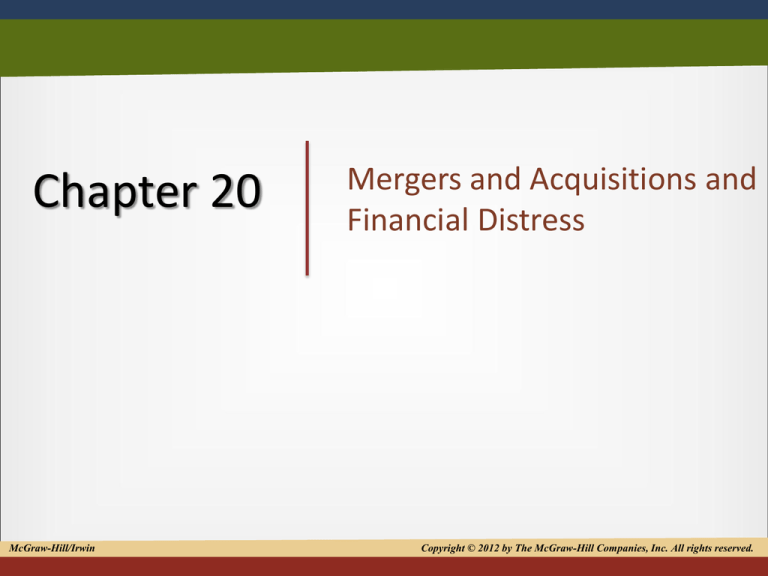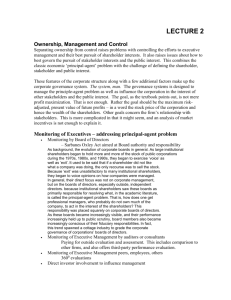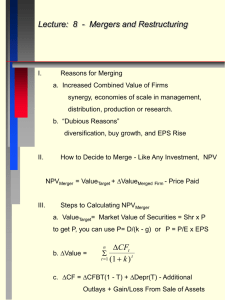
Chapter 20
McGraw-Hill/Irwin
Mergers and Acquisitions and
Financial Distress
Copyright © 2012 by The McGraw-Hill Companies, Inc. All rights reserved.
1
Introduction
• Mergers and acquisitions
– Firms combine
• Assets
• Liabilities
• Equity
20-2
Mergers & Acquisitions
• Merger — two firms combine to form one
larger firm
• Acquisition — one firm purchases another
• Consolidation — newly-created firm absorbs
bidder and target
20-3
Horizontal Mergers
• A horizontal merger is the combination of two
firms in the same industry
• Market extension merger (also horizontal)
combines two firms that sell the same product
in different markets
20-4
Vertical Merger
• Combines a firm with a supplier or distributor
– Avoids fixed costs
– Eliminates contracting, payment collection,
communication, advertising and coordination
costs
– Improves inventory planning
20-5
Conglomerate Merger
• Two companies merge that have no related
products or markets
– Popular in 1960s and 1970s, but dismantled in the
1980s and 1990s due to poor performance
20-6
Product Extension Merger
• Firms merge that sell different, but somewhat
related products
• A cross between horizontal and conglomerate
mergers
20-7
Revenue Enhancement
• Acquisition of firm in growing area may
enhance revenues
• The acquiring firm’s revenues may become
more stable
• Acquisition of new markets
20-8
Cost Reduction
• Economies of scale
– Reduce or eliminate redundancies in firm
– Cost of producing goods falls as size of firm
increases
20-9
Economies of Scale in Mergers
20-10
Long-Term Effect of Economies of Scale
20-11
Cost Reduction
• Economies of Scope
– Refers to merged firms’ abilities to generate
synergistic cost savings due to inter-relationship
among products and “jointness” in cost of
producing them
20-12
X-Efficiencies
• Not directly due to economies of scope or
scale
• Due to superior management as result of
replacing old, inefficient managers
20-13
Tax Considerations
• Tax gains from an acquisition can result from
– Net operating losses
– Unused debt capacity
– Surplus funds
20-14
Lowering the Cost of Capital
• A merger can lower a firm’s cost of capital
– Cost of issuing securities declines
– Diversification due to merger reduces debt risk of
merged firm, resulting in a lower interest rate
20-15
Managers’ Personal Incentives
• Managers’ personal wishes may drive merger
rather than sound economic basis
– Not favorable for the merged firm and can cause
stock price and shareholder’s wealth to decline
20-16
Valuing a Merger
• Net present value (NPV) or discounted cash flow
(DCF) method is most accurate method for
valuing a merger
– Forecasted cash flows discounted to PV based on
merged firm’s weighted average cost of capital
(WACC)
20-17
Financial Distress
• Economic Failure
• The return on a firm’s assets is less than the firm’s cost
of capital
• Business Failure
– The most extreme type of distress
– Firm is no longer in business
• Technical Insolvency
– A firm’s operating cash flows are not sufficient to
pay its liabilities as they come due
20-18
Firm-Specific Causes of
Financial Distress
•
•
•
•
Excess financial leverage
Highly volatile earnings stream
Poor management
Loss of key players on which production or
management depended
20-19
Market-Specific Causes of
Financial Distress
• Business cycle fluctuations
• High interest rates
20-20
Informal Resolutions
of Financial Distress
• Debt agreement restructuring
• Liquidation of firm’s assets
20-21
Restructuring a Firm’s Debt
Agreements
• Appropriate if financial distress is judged to be
temporary
• Creditors and firm restructure debt
agreements in a workout
20-22
Informal Liquidation of a Firm’s
Assets
• Termination of the firm as a going concern
• Assets sold; proceeds pay off the firm’s creditors
• Assignment passes liquidation of the firm’s assets
to third-party assignee or trustee
20-23
Federal Bankruptcy Laws
• Creditors can force the firm into bankruptcy if
informal restructure agreement not reached
• Firm can voluntarily file for bankruptcy
20-24
Bankruptcy Reform Act of 1978
• Chapter 11
– Firm in temporary financial distress can continue
operating while creditors’ claims settled
• Chapter 7
– Generally used if reorganization under Chapter 11
not feasible
20-25
Reorganization Procedures
in Bankruptcy
• Reorganization petition filed
• Federal judge reviews petition
– Firm submits reorganization plan within 120 days
– Court appoints creditor committees
20-26
Liquidation Procedures
in Bankruptcy
• Bankruptcy for firms too distressed to reorganize
via Chapter 7
• Trustee protects the creditors’ interests
• Priority of claims followed
20-27
Predicting Bankruptcy
• Broad types of credit scoring models
– Linear discriminant models
– Linear probability models
– Logit models
20-28












